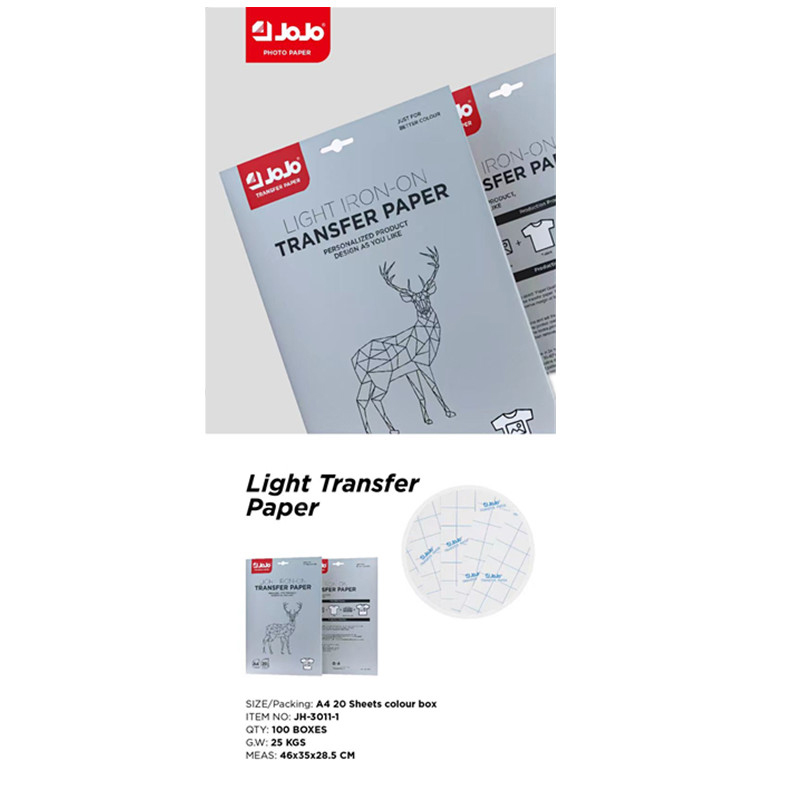If you need any help, please feel free to contact us
The Role Of Pressure And Temperature In Transfer Results
Heat transfer printing is a widely used technique in the field of digital printing and textile customization. It allows for detailed and colorful images to be transferred onto a variety of substrates, including fabrics, ceramics, and metals. Among the key factors influencing the quality of the final transfer, pressure and temperature stand out as two critical parameters. Understanding how these elements interact with different types of transfer papers, such as pearlized photo paper, high glossy photo paper, and RC coated photo paper can help professionals achieve consistent and desirable results.

Understanding Transfer Printing Basics
At its core, heat transfer printing involves printing an image onto a special paper and then using heat and pressure to transfer that image onto a target surface. The heat causes the ink or dye on the transfer paper to sublimate or melt, allowing it to bond with the substrate. Pressure ensures the transfer paper maintains intimate contact with the substrate during this process. Both elements must be carefully controlled for the transfer to adhere correctly and reproduce accurate colors and details.
The Influence of Temperature
Temperature is vital because it activates the transfer medium’s chemistry. When using heat transfer papers, each type has a recommended temperature range that ensures proper melting or sublimation of inks. If the temperature is too low, the ink may not fully transfer, resulting in dull or patchy images. On the other hand, excessively high temperatures can cause the transfer paper to scorch or the substrate to warp, the pilot to distort or fade.
For example, when using pearlized photo paper, which has a shimmering surface finish that enhances metallic or pearlescent effects, maintaining the recommended temperature is essential. This specialized paper contains coatings that react to heat in a way that preserves the unique pearlescent quality. Too much heat may damage the delicate surface and diminish the visual effect, while too little heat may cause incomplete image transfer.
Similarly, high glossy photo paper requires precise temperature control to maintain its reflective and smooth surface after transfer. This paper type typically has a polymer coating designed to produce sharp, vibrant images with a mirror-like finish. Proper temperature ensures that the ink fuses well with the coating without compromising the glossiness.
RC coated photo paper, known for its resin-coated base, benefits from stable temperature settings as well. The resin coating improves moisture resistance and dimensional stability during printing and transfer. Temperature fluctuations can affect the resin’s performance, potentially pilot to surface bubbling or incomplete ink fixation.
The Impact of Pressure
Pressure plays an equally important role in heat transfer printing. Applying sufficient pressure ensures that the transfer paper and substrate have close contact, allowing for uniform ink adhesion. Uneven pressure can cause parts of the image to transfer improperly, leaving streaks, blurs, or faded areas.
When working with textured surfaces or thick materials, adjustments to pressure may be necessary. For instance, transferring onto a fabric with a coarse weave might require higher pressure to push the ink into the fibers effectively. Conversely, overly high pressure on delicate or thin substrates could cause damage or distortion.
Pearlized photo paper, with its distinct textured coating, often requires moderate but consistent pressure to ensure the pearlescent ink layers transfer evenly without crushing the surface texture.
In contrast, high glossy photo paper often demands a firm and evenly distributed pressure to avoid air pockets or uneven contact that can affect the reflective surface and image sharpness.
For RC coated photo paper, the resin layer provides some tolerance, allowing for effective transfers at moderate pressure levels. However, insufficient pressure can result in patchy adhesion, particularly with high-resolution images.
Balancing Pressure and Temperature
Finding the right balance between pressure and temperature is essential. These two parameters work synergistically: temperature activates the transfer chemistry, while pressure facilitates the transfer’s physical adherence. Adjustments to one often require changes to the other.
For example, if a substrate is sensitive to heat and cannot withstand high temperatures, increasing the pressure slightly might compensate to ensure better transfer. Conversely, if a substrate cannot handle strong pressure, raising the temperature within a safe range might help improve ink adhesion.
Operators often conduct test transfers to dial in the correct settings for each paper-substrate combination. This is particularly important with specialty papers such as pearlized photo paper, where maintaining visual effects is critical, or high glossy photo paper, where finish quality is paramount.
Additional Considerations
Apart from pressure and temperature, factors such as transfer time and cooling rate also influence the final outcome. Longer transfer times can sometimes compensate for lower temperatures, while proper cooling ensures the ink sets firmly without smudging.
Choosing the right transfer paper is another key element. The type of coating on the paper—whether resin-coated, pearlized, or glossy—affects how it reacts under heat and pressure. Understanding the material properties helps optimize the process and avoid common issues such as wrinkling, peeling, or color fading.
Heat transfer printing involves a delicate balance of multiple variables, with pressure and temperature being two of the more influential. Whether using pearlized photo paper, high glossy photo paper, or RC coated photo paper, understanding their unique properties and how they respond to heat and pressure is essential for producing consistent, high-quality transfers. Careful control and testing of these parameters will help operators achieve vivid, durable prints across a wide range of applications.

 English
English Español
Español 中文简体
中文简体 Português
Português

